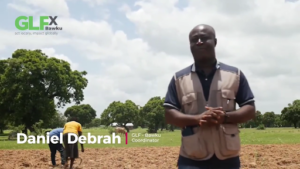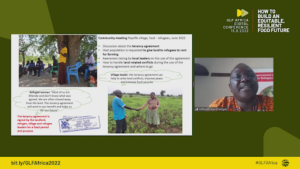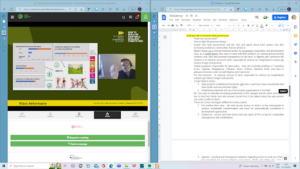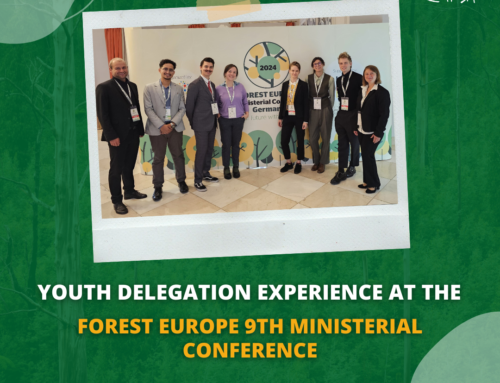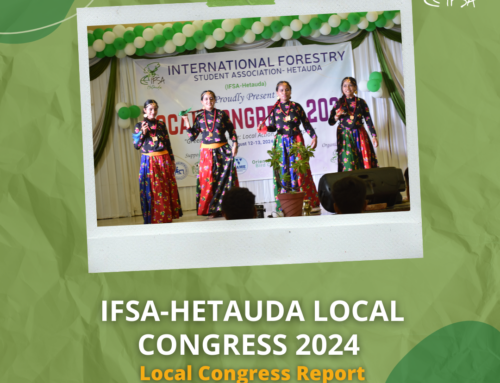GLF Africa 2022 Article- IFSA Delegation
How to build an equitable, resilient food future.
1. Introduction
Global Landscape Forum(GLF)
The Global Landscapes Forum (GLF) is the world’s largest knowledge-led platform on integrated land use. It is scaling up to significantly contribute towards the Sustainable Development Goals (SDGs) and the Paris Agreement led by CIFOR in collaboration with its co-founders, UNEP and the World Bank, and charter members. The forum has five broad themes covering food and livelihoods, rights (gender, tenure, community, and indigenous), landscape restoration, financing sustainable landscapes, and measuring progress.
Twenty-three delegates from IFSA attended the GLF Africa 2022 Digital Conference on September 15th, 2022, under the theme “How to Build an Equitable, Resilient Food Future ”. The conference had three thematic areas; sustainable finance: from markets to value chains; resilient, regenerative landscapes: from restoration to agroecology and landscape rights: from inclusive tenure to policy change bringing 178 speakers and 15 agendas to discuss and address the issue of food security in Africa.
Food security in Africa remains a big problem to this day. With that in mind, the “GLF Africa Digital Conference seeks to improve food conditions in the present and secure a better food future for Africa. It consisted of 31 different sessions in a single day, with French and English used to deliver the conference. Speakers from Africa and outside of Africa participated in these sessions. They varied from country officials, private sector spokespersons, young entrepreneurs, local leaders like the tribe’s chieftains, and even artists. Solutions to the main theme were presented from many points of view, from local communities, stakeholders, experts, youth, and even indigenous leaders of Africa.
Delegation Experience
The twenty-three online delegates from IFSA had a chance to attend GLF Africa virtually and gain prestigious knowledge from the incredibly experienced speakers. They regarded the sessions as interesting and supported the realization of the goal of participating in this delegation which would undoubtedly benefit the IFSA community. In this delegation, they listened in, noted the speaker’s explanation according to their respective sessions, and held brief discussions on the topics.
2. Session highlights
Sustainable finance: from markets to value chains
In this section, there is a need to incorporate youth into local and global discussions. Young people need global access and indigenous knowledge, as they can be the answer to today’s food problems in Africa by creating nature-based solutions. Youth is the future, so involve them in local and global discussions.
Knowledge is used to connect, so it needs to be passed on to the younger generation to improve the food sovereignty agenda. In its involvement, Africa dominates dry land. Therefore, an area needs to be restored, but the parties must be close to the community. Restoration must support local wisdom and investment in improving the economy.
Through the concept of an ecosystem for innovation in Africa, there were four things to know: a clear idea, the risks in overcoming the challenge, the need for leapfrog innovation is a must, and knowing what innovation is for Africa. Simply put, we set our mindset from poverty to prosperity and develop a robust innovation ecosystem in action for Africa and its potential in human resources such as women and youth.
Resilient, regenerative landscapes: from restoration to agroecology
The cause of the global diversity crisis and the opportunity to address it is linked to how nature is valued in political and economic decisions at all levels. There is a need for policies that support landscape restoration at the local, national, and international levels. At the local level, we need policies that put communities at the center of certain projects. At the national level, there is a need to promote biodiversity conservation. At the international level, policies need to make the supply chain behind forest landscapes more suitable. Transformative change can be achieved if there is a focus shift from the immediate results, and we can think long-term to achieve sustainable restoration. So transformative policies are important for a country’s development because conservation is connected to different development sectors.
In landscape investment, indigenous people need to be treated as partners so they would invest in agroforestry and contribute to preserving the forest. Landscape communities living adjacent to forests, rangelands, and other ecosystems are critical to achieving national and global restoration targets and must be involved in the design and implementation.
However, long-term investment is needed to align legitimate land tenure rights with conservation and restoration needs. Restoration risks serious human rights violations if we do not recognize people’s rights. This can prevent the creation of incentives for communities to invest in land restoration. The transition from normal restoration to agroecology is also important because when everything shifts to agroecology, there is continuity and balance in the ecosystem, which will benefit all parties.
Voices of the Landscape: A day in the field
The session involved a field assessment of farmers in different regions of Africa on their perception of plant growth using fertilizers, restoration efforts in degraded areas, and general sources of livelihood to rural farmers by Daniel Debrah, the Bawky coordinator for GLF. (Global landscape forum)
It was an interesting session with beneficial views of farmers upon their predicament and several measures they have taken to combat the issues. Below are some of their observations.
The land is very important for planting activities. Each region has different field problems. In several cases of the Sumbrungu community visited by GLFx Bawku, there was an error in the fertilization used for plants that damaged the land and gave poor results. This causes farmers to only plant soybeans, corn, and rice, focus on NPK fertilizers, and return to using agroecology for plantations. Besides that, women in the regions should also be used to increase their tree productivity, namely women planting shea trees and collecting shea fruit to be used as shea butter to support household income.
In contrast, the GLFx Yaounde aims to plant trees for climate change mitigation and food security in Cameroon. They also hope its potential can be used to improve the surrounding community’s economy and suppress deforestation. Like other cooperative principles, GLFx Nairobi has also implemented this with a focus on community collaboration called LEWMO, which is based on the efforts of solid waste management organizations.
In short, it means that the community must cooperate with parties who know clearly about the planting and its pattern to produce improvements both in terms of knowledge, social, and economy, which of course, can be beneficial for the community, especially in the area concerned.
Landscape rights: from inclusive tenure to policy change
Walk the talk of inclusive land governance – Practical approaches and voices from stakeholders
Everyone’s hope as stakeholders is to work with their partners on solving and preventing conflicts over land and promoting transparency in the land. In this session, there were six speakers such as Klaus Ackermann (Head of Global Programme Responsible Land Policy GIZ), Dieundonne Annir (Mayor in Yoko, central region, Cameroon), Wilfred Babanga (Program Manager Zoa Uganda), Martin Hoppe (Head of Division Food and Nutrition Security, Global Food Policy, Fisheries, BMZ), Maria Joanitah Ndagire (Technical Advisor, GIZ), and Bala Wenceslas Sanou (Co-Founder of IRI).
With the main target of women and youth/marginalized groups, three actions are urgently needed; improving the institutional framework by counting how many households have better and secured land rights, strengthening CSO for participating in the formulation and implementation of land policies—underlining the important role of a civil society organization in the land and improving the framework condition for responsible agricultural and forestry investments.
The speakers highlighted that we need to solve problems and give contributions. Three key messages were different in every case for Burkina Faso, Cameroon, and Uganda. For Burkina Faso, there were three plans to solve the problem/provide contributions, such as knowing the context of the problem, approaches, and giving recommendations (dialogue, synergizing with local structures, for example, through approaches, and carrying out plans in the village). Cameroon needs to look for the secure land tenure and user rights of IPLC. Also, Uganda needs to look for a practical and transparent solution regarding access to and use of land. Simply put, the most highlighted aspect is how each stakeholder can provide assistance and cooperation to one another. It means inspiring action for better sustainable landscapes that “leave no one behind.”
Land, Food, and Climate: African solution for food and climate resilience.
A large part of Africa is facing a monumental food crisis due to the decrease in agricultural productivity caused by climate change, with about 22 million people at risk of starvation in the drought-hit Horn of Africa alone. In this plenary, the speakers discussed key tools to power the transition into a food and climate-resilient continent, including finance for farmers, capacity building, community mobilization, and new narratives around African food sovereignty.
There is a need for Africa to adapt fast to climate change if we are to protect the landscape and achieve sustainable development goals. Adaptation can be achieved to increase agricultural productivity in different ways, such as political commitment from all levels of government, implementation of adaptation action into the institutional framework, enhancing educational and information programs, and monitoring and evaluation to track progress for effective decision-making.
Also, smallholders should be given more support because they produce about one-third of the global food system. The speaker mentioned three points that could help increase food security and support African smallholders—first, the nexus between adaptation and (equity) in the climate action sector. The second point is the need for innovative approaches to finance to scale up adaptation practices and technologies for smallholders. The last point is the need for urgency as climate change is on the rise, and we need a more holistic response to manage multiple and future crises that threaten the security of humans.
There was a discussion on initiatives recognizing and developing solutions to improve food security and adaptation in Africa. These include the use of data collected from the satellite to increase agricultural productivity, increase the control of damage and risk to the landscape and monitor the state of the earth and the effect of some human activities on it, and prevent post-harvest loss by providing food for those who need it at a reasonable price and improving the value of food for the farmer.
Realizing the full potential of trees for adaptation and resilience
Food security is not just about the quantity of food produced but also the quality. Due to the broken global food system and the way we use our land to produce food and other goods and services, food production is responsible for a quarter of all anthropogenic GHG emissions, 90% of deforestation and nearly 70% of species loss and this has left about 2 billion of the world’s population deprived of the necessary nutrients needed for a healthy living.
Transforming the food system in Africa, Trees and forests are key nature-based solutions that can provide an inclusive, resilient, and safe food system for all. By achieving a sustainable food system, there is a major link to the trees and forest to increase the nutritional value of food, and the quantity of food and support ecosystem service to improve agricultural productivity. However, Transformation can only be achieved fully if solutions are developed and designed without leaving out the values, needs, and interests of the stakeholders involved because there is a huge challenge between economic interest and ecological interest.
The way forward on how trees can transform the food system was the highlight of the session; different approaches, such as improving existing tree-based agricultural system solutions, reorienting agricultural investment into sustainable, nutrient-dense food, integrating food and nutrient objectives into the broader initiative for forest restoration and conservation practices and policies to achieve multiple benefits and sustainable production practice by implementing policies that support the production and the consumption of nutrient-dense food without leaving the stakeholders out were discussed. We are on our way toward food security, but we must do more to achieve stability.
Restoration education summit
Education is one of the major tools to achieve landscape restoration, and restoration has to move from simply growing trees to a transformative direction. There is a pressing need to enhance restoration education and create trans-disciplinary and interdisciplinary curriculums through formal and informal means to channel capacity building and education in the right direction.
The learning hub would provide a holistic approach to ecosystem restoration through 3 main pillars: field-based, job-based, and academia based. These pillars aim to involve everyone from all levels (individuals, educators, organizations, and government agencies) in the landscape restoration plan. The speakers discussed some implementation plans they are planning to see restoration come to play. These plans include the implementation of a restoration education curriculum in the already existing university curriculum, inclusion and involvement of children and youths in the restoration plan, and partnership with organizations to seek their help and involve them in the trans-formative education on landscape restoration.
An inclusive restoration education would bring to reality a future where every individual, from the farmer to the highest office in any community, participates in the restoration of the landscape to bring about food security.
Valuing biodiversity to restore resilient landscapes–The role of transformative policies
It is important to Strengthen pro-environmental values and paradigms in society because only this would result in political pressure and eventually birth good policies. Good policies can only be birthed by understanding the value of nature to local and indigenous communities through their worldview and applying locally established procedures.
Achieving sustainable landscape restoration policy requires institutions that enable the recognition and integration of diverse values of nature and nature’s contribution to people. Transformative change can only be achieved if there is a focus shift from the immediate result, and we can think long-term to achieve sustainable restoration.
The forest landscape restoration (FLR) approaches and the development of sustainable value chains can only be successful in the long term if embedded in an enabling policy environment. Transformative policies are important for the continent’s development because conservation is connected to different sectors necessary for development.
Sustainable Wildlife Management
Sustainable Wildlife Management (SWM) Programme seeks to stop wild meat/bushmeat degradation. Bush meats are hunted by wildlife or wild animals. Some are unsafe as they contain pathogens, bacteria, or viruses. Most of these meats are endangered and protected animals that we see their bodies in the markets.
The overarching question is, why are these bush meats so popular anyway? The lack of “good meat” is the reason. “Good meat” like beef and chicken is an expensive source of protein because it is hard to obtain them. For example, at the conference, we saw a photo of a farmer holding a jaw bone from his dead cow (taken by Brent Stirton, Getty Images and National Geographic photographer). The farmer’s cow died in a lion’s attack, which means there are a lot of threats to herding farm animals since wild predators are causing heavy losses, and the price of beef and chicken are high. So, what is the solution to this bushmeat consumption problem? As Robert Nasi, CIFOR’s Director General, said, “SWM Programme wishes to reduce demands for bushmeat by providing alternatives like fish, chicken, or insects.”
To sum it up, biodiversity degradation from bushmeat consumption must be reduced by giving people alternatives to better meat sources. This will provide a much healthier and better food future for Africa.
3. Conclusion
GLF Africa 2022 digital conference was focused on sustainable finance, regenerative land, and ownership rights. In the discussions, the main involvement was related to youth, women, and other stakeholders. Many suggestions were obtained in this event to advance some of the discussed sectors. This is important, considering that it is a benchmark in the implementation and role of everyone for the advancement of food security in Africa.
The speakers shared knowledge about policies that have been made and responded well to the welfare of local communities so that they can manage forests without being constrained by policies that are too rigid and limit ambiguous agreements to political needs. Then that means some suggestions and changes are needed, for example, our mindset and actions!
Reference
https://events.globallandscapesforum.org/africa-2022/
Author: Elivis Omoit, Head of Sub-Commission CIFOR/YIL
Contributors to the article: Fiana Eka Aprilia, Ayomide M.adetula, Fajilade Oluwanifemi, MurtadhaIbrahimMuhammad, Enyi Clarissa Chimeremeze, Sakshi Thapliyal, Vincentius Andri Kiranu Pasquale

